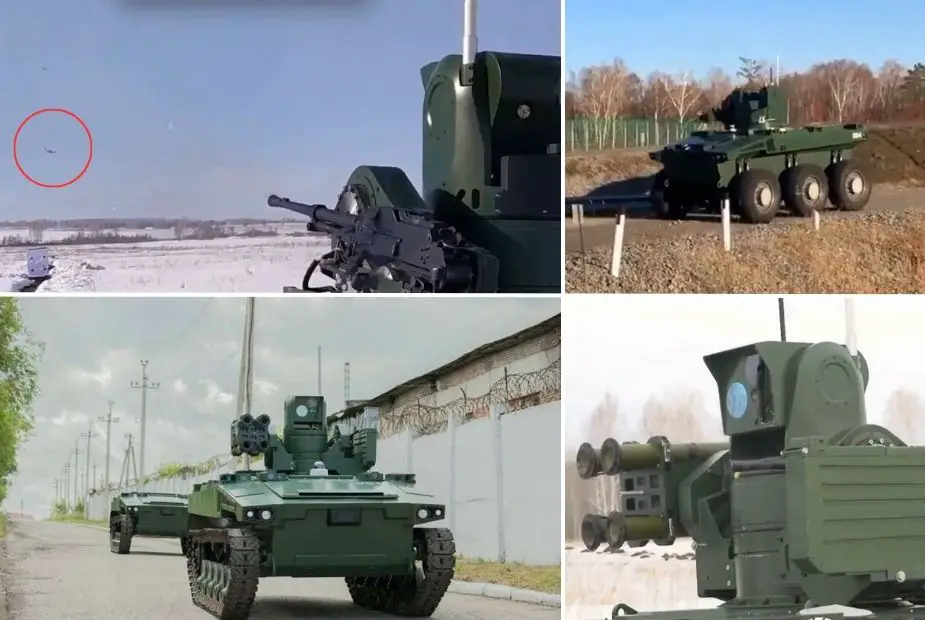- Army
- Conflicts in the world
- Israel - Iran conflict 2025
- Pakistan - India Conflict 2025
- Russia Ukraine War 2022
- Libya conflict day by day
- HAMAS - Israel War 2023
- Operation Serval in Mali French Army
- Sangaris operation Central African Republic
- Sangaris opération militaire République Centreafrique
- Ukraine - Russia conflict
- Syria conflict news
- Defence & Security Industry Technology
- Armies in the world
- Analysis Defense and Security Industry
- Conflicts in the world
- Navy
- Air
Russian Army Deploys Marker Drones for the First Time in Ukraine
As unmanned vehicles gradually conquered the battlefield, during the Berdychi attack in Ukraine, the Russian army used Marker attack drones equipped with AGS-17 40mm grenade launchers for the first time since the creation of the Northern Military Region, as reported by the Polish Center for Eastern European Studies (OSW).
Follow Army Recognition on Google News at this link

The Marker can be equipped with a variety of fire suppression systems, from anti-tank systems to heavy machine guns, and can be mounted on either wheels or tracks (Picture source: Marker NPO )
The Russian Marker Unmanned Ground Vehicle (UGV) represents a convergence of cutting-edge robotics and military strategy, intended to enhance tasks in reconnaissance, logistics, and combat. This initiative to integrate unmanned systems into the battlefield aims to reduce risks to human personnel while potentially enhancing the effectiveness of military operations. Leveraging artificial intelligence (AI) and robotic technology, the Marker UGV can perform tasks typically requiring human intervention, marking a significant advancement in autonomous and semi-autonomous military capabilities.
In terms of armament, the Marker UGV boasts versatility, with the ability to be equipped with various weapons tailored to specific mission requirements and operational needs. Typically armed with machine guns, it provides a foundational level of firepower suitable for engaging lightly armored targets or infantry. Additionally, the UGV can carry grenade launchers, expanding its capacity to deliver versatile and potent ordnance against a range of targets. Anti-tank guided missiles (ATGMs) further augment their arsenal, enabling the Marker to engage and neutralize heavily armored vehicles, including tanks, at significant distances. Beyond conventional weaponry, the Marker is designed to support electronic warfare (EW) tools, enabling it to jam enemy communications and disrupt electronic systems, thereby providing a strategic advantage in modern combat scenarios.
Weighing nearly three tons and lacking a pilot onboard, the Marker resembles a tank in shape but is smaller in size. It can be operated remotely or autonomously thanks to an integrated artificial intelligence system. Developed in 2018 by the Russian Foundation for Advanced Studies (FPI) and Android Technology, the Marker features a rotating support module as its base, accommodating a range of fire suppression systems, from anti-tank weaponry to heavy machine guns, and can be mounted on either wheels or tracks. Recent tests have demonstrated its capability to cover up to 100 kilometers in five hours, both on- and off-road, with the added ability to traverse rivers. With a turret capable of rotating 540 degrees in one second, the Marker can swiftly track targets, further enhanced by its integration with a swarm of drones, bolstering its surveillance capabilities and enabling it to detect distant threats.
The ramifications of this novel form of warfare have been widely discussed by international observers. David Axe from Forbes reported that although two Russian drones were neutralized by Ukrainian aerial drones, the impact of this robotic attack was substantial. Samuel Bendett, an advisor at the American Center for Naval Analyses (CNA), noted that Ukraine's airspace is heavily populated with drones, making every movement on the battlefield a potential target for drone strikes.
In response to this escalating threat, Ukraine is advancing its production of FPV drones, capable of carrying small explosive payloads with high precision. The Kyiv regime aims to produce up to 50,000 of these drones monthly, although the actual progress toward this goal remains unclear.
"Drone battles" in the North Military Region have already been recorded. For example, near Avdeevka. A video has appeared on social media: a Russian drone (logistics robot) delivering ammunition to a unit is suddenly hit by lingering munitions (kamikaze drone). There are many similar cases.
Alongside the increase in drone usage, defensive measures are also being enhanced. New Russian armored vehicles are now routinely outfitted with drone protection, colloquially termed "barbecues" due to their original makeshift design. These adaptations underscore the growing need for effective defenses against both aerial and ground-based robotic threats.
The battle near Berdychi thus highlights the increasingly critical role of drones and other robotic platforms in modern military strategy. Previously utilized for logistical or rescue tasks, these technologies are now at the forefront of armed confrontations. Ground drones like the "Marker" and Ukraine's "Ironclad," which are controlled by neural networks, signify an era where robotic warfare is becoming a central element of military operations. These developments are set to profoundly alter traditional military tactics, with human involvement diminishing in the most hazardous operations.
News Russia Ukraine War


























